Texts in Applied Mathematics 45
Editors
J.E. Marsden
L. Sirovich
S.S. Antman
Advisors
G. Iooss
P. Holmes
D. Barkley
M. Dellnitz
P. Newton
�
Texts in Applied Mathematics
Sirovich: Introduction to Applied Mathematics.
1.
2. Wiggins: Introduction to Applied Nonlinear Dynamical Systems and Chaos.
3.
4.
5.
6.
Hale/Koçak: Dynamics and Bifurcations.
Chorin/Marsden: A Mathematical Introduction to Fluid Mechanics, Third Edition.
Hubbard/West: Differential Equations: A Dynamical Systems Approach: Ordinary
Differential Equations.
Sontag: Mathematical Control Theory: Deterministic Finite Dimensional Systems,
Second Edition.
Perko: Differential Equations and Dynamical Systems, Third Edition.
Seaborn: Hypergeometric Functions and Their Applications.
Pipkin: A Course on Integral Equations.
7.
8.
9.
10. Hoppensteadt/Peskin: Modeling and Simulation in Medicine and the Life Sciences,
Second Edition.
11. Braun: Differential Equations and Their Applications, Fourth Edition.
12. Stoer/Bulirsch: Introduction to Numerical Analysis, Third Edition.
13. Renardy/Rogers: An Introduction to Partial Differential Equations.
14. Banks: Growth and Diffusion Phenomena: Mathematical Frameworks and
Applications.
15. Brenner/Scott: The Mathematical Theory of Finite Element Methods, Second Edition.
16. Van de Velde: Concurrent Scientific Computing.
17. Marsden/Ratiu: Introduction to Mechanics and Symmetry, Second Edition.
18. Hubbard/West: Differential Equations: A Dynamical Systems Approach:
Higher-Dimensional Systems.
19. Kaplan/Glass: Understanding Nonlinear Dynamics.
20. Holmes: Introduction to Perturbation Methods.
21. Curtain/Zwart: An Introduction to Infinite-Dimensional Linear Systems Theory.
22. Thomas: Numerical Partial Differential Equations: Finite Difference Methods.
23. Taylor: Partial Differential Equations: Basic Theory.
24. Merkin: Introduction to the Theory of Stability.
25. Naber: Topology, Geometry, and Gauge Fields: Foundations.
26. Polderman/Willems: Introduction to Mathematical Systems Theory: A Behavioral
Approach.
27. Reddy: Introductory Functional Analysis: with Applications to Boundary Value
Problems and Finite Elements.
28. Gustafson/Wilcox: Analytical and Computational Methods of Advanced Engineering
Mathematics.
29. Tveito/Winther: Introduction to Partial Differential Equations: A Computational
Approach.
30. Gasquet/Witomski: Fourier Analysis and Applications: Filtering, Numerical
Computation, Wavelets.
31. Brémaud: Markov Chains: Gibbs Fields, Monte Carlo Simulation, and Queues.
32. Durran: Numerical Methods for Wave Equations in Geophysical Fluid Dynamics.
33. Thomas: Numerical Partial Differential Equations: Conservation Laws and Elliptic
Equations.
(continued after index)
�
Stig Larsson · Vidar Thomée
Partial
Differential Equations
with Numerical
Methods
123
�
Stig Larsson
Vidar Thomée
Mathematical Sciences
Chalmers University of Technology
and University of Gothenburg
412 96 Göteborg
Sweden
stig@chalmers.se
thomee@chalmers.se
Series Editors
J.E. Marsden
Control and Dynamical Systems, 107-81
California Institute of Technology
Pasadena, CA 91125
USA
marsden@cds.caltech.edu
L. Sirovich
Laboratory of Applied Mathematics
Mt. Sinai School of Medicine
Box 1012
New York City, NY 10029-6574
USA
lawrence.sirovich@mssm.edu
First softcover printing 2009
S.S. Antman
Department of Mathematics
and
Institute for Physical Science
and Technology
University of Maryland
College Park, MD 20742-4015
USA
ssa@math.umd.edu
ISBN 978-3-540-88705-8
e-ISBN 978-3-540-88706-5
DOI 10.1007/978-3-540-88706-5
Texts in Applied Mathematics ISSN 0939-2475
Library of Congress Control Number: 2008940064
Mathematics Subject Classification (2000): 35-01, 65-01
c 2009, 2003 Springer-Verlag Berlin Heidelberg
This work is subject to copyright. All rights are reserved, whether the whole or part of the material is
concerned, specifically the rights of translation, reprinting, reuse of illustrations, recitation, broadcasting,
reproduction on microfilm or in any other way, and storage in data banks. Duplication of this publication
or parts thereof is permitted only under the provisions of the German Copyright Law of September 9,
1965, in its current version, and permission for use must always be obtained from Springer. Violations
are liable to prosecution under the German Copyright Law.
The use of general descriptive names, registered names, trademarks, etc. in this publication does not imply,
even in the absence of a specific statement, that such names are exempt from the relevant protective laws
and regulations and therefore free for general use.
Coverdesign: WMXDesign GmbH, Heidelberg
Printed on acid-free paper
9 8 7 6 5 4 3 2 1
springer.com
�
Series Preface
Mathematics is playing an ever more important role in the physical and
biological sciences, provoking a blurring of boundaries between scientific
disciplines and a resurgence of interest in the modern as well as the classical
techniques of applied mathematics. This renewal of interest, both in re-
search and teaching, has led to the establishment of the series Texts in
Applied Mathematics (TAM).
The development of new courses is a natural consequence of a high level
of excitement on the research frontier as newer techniques, such as numeri-
cal and symbolic computer systems, dynamical systems, and chaos, mix
with and reinforce the traditional methods of applied mathematics. Thus,
the purpose of this textbook series is to meet the current and future needs
of these advances and to encourage the teaching of new courses.
TAM will publish textbooks suitable for use in advanced undergraduate
and beginning graduate courses, and will complement the Applied Mathe-
matical Sciences (AMS) series, which will focus on advanced textbooks and
research-level monographs.
Pasadena, California
New York, New York
College Park, Maryland
J.E. Marsden
L. Sirovich
S.S. Antman
�
Preface
Our purpose in this book is to give an elementary, relatively short, and hope-
fully readable account of the basic types of linear partial differential equations
and their properties, together with the most commonly used methods for their
numerical solution. Our approach is to integrate the mathematical analysis
of the differential equations with the corresponding numerical analysis. For
the mathematician interested in partial differential equations or the person
using such equations in the modelling of physical problems, it is important
to realize that numerical methods are normally needed to find actual values
of the solutions, and for the numerical analyst it is essential to be aware that
numerical methods can only be designed, analyzed, and understood with suf-
ficient knowledge of the theory of the differential equations, using discrete
analogues of properties of these.
In our presentation we study the three major types of linear partial differ-
ential equations, namely elliptic, parabolic, and hyperbolic equations, and for
each of these types of equations the text contains three chapters. In the first
of these we introduce basic mathematical properties of the differential equa-
tion, and discuss existence, uniqueness, stability, and regularity of solutions
of the various boundary value problems, and the remaining two chapters are
devoted to the most important and widely used classes of numerical methods,
namely finite difference methods and finite element methods.
Historically, finite difference methods were the first to be developed and
applied. These are normally defined by looking for an approximate solution
on a uniform mesh of points and by replacing the derivatives in the differential
equation by difference quotients at the mesh-points. Finite element methods
are based instead on variational formulations of the differential equations and
determine approximate solutions that are piecewise polynomials on some par-
tition of the domain under consideration. The former method is somewhat
restricted by the difficulty of adapting the mesh to a general domain whereas
the latter is more naturally suited for a general geometry. Finite element
methods have become most popular for elliptic and also for parabolic prob-
lems, whereas for hyperbolic equations the finite difference method continues
to dominate. In spite of the somewhat different philosophy underlying the
two classes it is more reasonable in our view to consider the latter as further
�
VIII
Preface
developments of the former rather than as competitors, and we feel that the
practitioner of differential equations should be familiar with both.
To make the presentation more easily accessible, the elliptic chapters are
preceded by a chapter about the two-point boundary value problem for a
second order ordinary differential equation, and those on parabolic and hy-
perbolic evolution equations by a short chapter about the initial value prob-
lem for a system of ordinary differential equations. We also include a chapter
about eigenvalue problems and eigenfunction expansion, which is an impor-
tant tool in the analysis of partial differential equations. There we also give
some simple examples of numerical solution of eigenvalue problems.
The last chapter provides a short survey of other classes of numerical
methods of importance, namely collocation methods, finite volume methods,
spectral methods, and boundary element methods.
The presentation does not presume a deep knowledge of mathematical and
functional analysis. In an appendix we collect some of the basic material that
we need in these areas, mostly without proofs, such as elements of abstract
linear spaces and function spaces, in particular Sobolev spaces, together with
basic facts about Fourier transforms. In the implementation of numerical
methods it will normally be necessary to solve large systems of linear algebraic
equations, and these generally have to be solved by iterative methods. In a
second appendix we therefore include an orientation about such methods.
Our purpose has thus been to cover a rather wide variety of topics, notions,
and ideas, rather than to expound on the most general and far-reaching
results or to go deeply into any one type of application. In the problem
sections, which end the various chapters, we sometimes ask the reader to
prove some results which are only stated in the text, and also to further
develop some of the ideas presented. In some problems we propose testing
some of the numerical methods on the computer, assuming that Matlab or
some similar software is available. At the end of the book we list a number
of standard references where more material and more detail can be found,
including issues concerned with implementation of the numerical methods.
This book has developed from courses that we have given over a rather
long period of time at Chalmers University of Technology and G¨oteborg Uni-
versity originally for third year engineering students but later also in begin-
ning graduate courses for applied mathematics students. We would like to
thank the many students in these courses for the opportunities for us to test
our ideas.
G¨oteborg,
January, 2003
Stig Larsson
Vidar Thom´ee
In the second printing 2005 we have corrected several misprints and minor
SL & VT
inadequacies, and added a few problems.
�
Contents
1
1
Introduction . . . . . . . . . . . . . . . . . . . . . . . . . . . . . . . . . . . . . . . . . . . . . .
1
1.1 Background . . . . . . . . . . . . . . . . . . . . . . . . . . . . . . . . . . . . . . . . . . . .
4
1.2 Notation and Mathematical Preliminaries . . . . . . . . . . . . . . . . . .
1.3 Physical Derivation of the Heat Equation . . . . . . . . . . . . . . . . . .
7
1.4 Problems . . . . . . . . . . . . . . . . . . . . . . . . . . . . . . . . . . . . . . . . . . . . . . 12
2 A Two-Point Boundary Value Problem . . . . . . . . . . . . . . . . . . . 15
2.1 The Maximum Principle . . . . . . . . . . . . . . . . . . . . . . . . . . . . . . . . . 15
2.2 Green’s Function . . . . . . . . . . . . . . . . . . . . . . . . . . . . . . . . . . . . . . . 18
2.3 Variational Formulation . . . . . . . . . . . . . . . . . . . . . . . . . . . . . . . . . 20
2.4 Problems . . . . . . . . . . . . . . . . . . . . . . . . . . . . . . . . . . . . . . . . . . . . . . 23
3 Elliptic Equations . . . . . . . . . . . . . . . . . . . . . . . . . . . . . . . . . . . . . . . . 25
3.1 Preliminaries . . . . . . . . . . . . . . . . . . . . . . . . . . . . . . . . . . . . . . . . . . . 25
3.2 A Maximum Principle . . . . . . . . . . . . . . . . . . . . . . . . . . . . . . . . . . . 26
3.3 Dirichlet’s Problem for a Disc. Poisson’s Integral . . . . . . . . . . . 28
3.4 Fundamental Solutions. Green’s Function . . . . . . . . . . . . . . . . . . 30
3.5 Variational Formulation of the Dirichlet Problem . . . . . . . . . . . 32
3.6 A Neumann Problem . . . . . . . . . . . . . . . . . . . . . . . . . . . . . . . . . . . 35
3.7 Regularity . . . . . . . . . . . . . . . . . . . . . . . . . . . . . . . . . . . . . . . . . . . . . 37
3.8 Problems . . . . . . . . . . . . . . . . . . . . . . . . . . . . . . . . . . . . . . . . . . . . . . 38
4 Finite Difference Methods for Elliptic Equations . . . . . . . . . . 43
4.1 A Two-Point Boundary Value Problem . . . . . . . . . . . . . . . . . . . . 43
4.2 Poisson’s Equation . . . . . . . . . . . . . . . . . . . . . . . . . . . . . . . . . . . . . 46
4.3 Problems . . . . . . . . . . . . . . . . . . . . . . . . . . . . . . . . . . . . . . . . . . . . . . 49
5 Finite Element Methods for Elliptic Equations . . . . . . . . . . . . 51
5.1 A Two-Point Boundary Value Problem . . . . . . . . . . . . . . . . . . . . 51
5.2 A Model Problem in the Plane . . . . . . . . . . . . . . . . . . . . . . . . . . . 57
5.3 Some Facts from Approximation Theory . . . . . . . . . . . . . . . . . . . 60
5.4 Error Estimates . . . . . . . . . . . . . . . . . . . . . . . . . . . . . . . . . . . . . . . . 63
5.5 An A Posteriori Error Estimate . . . . . . . . . . . . . . . . . . . . . . . . . . 66
5.6 Numerical Integration . . . . . . . . . . . . . . . . . . . . . . . . . . . . . . . . . . . 67
5.7 A Mixed Finite Element Method . . . . . . . . . . . . . . . . . . . . . . . . . 71
5.8 Problems . . . . . . . . . . . . . . . . . . . . . . . . . . . . . . . . . . . . . . . . . . . . . . 73
�
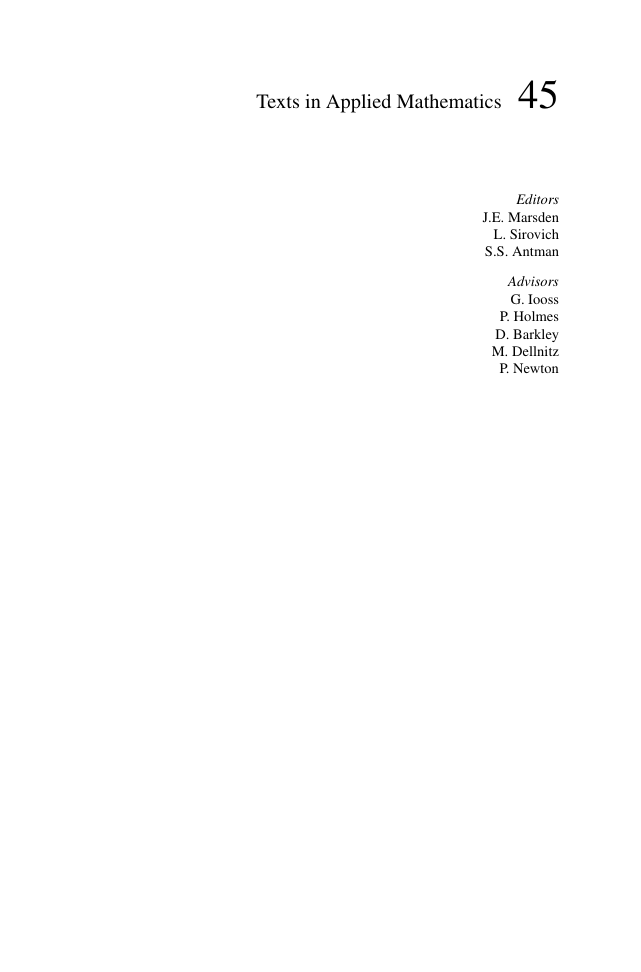

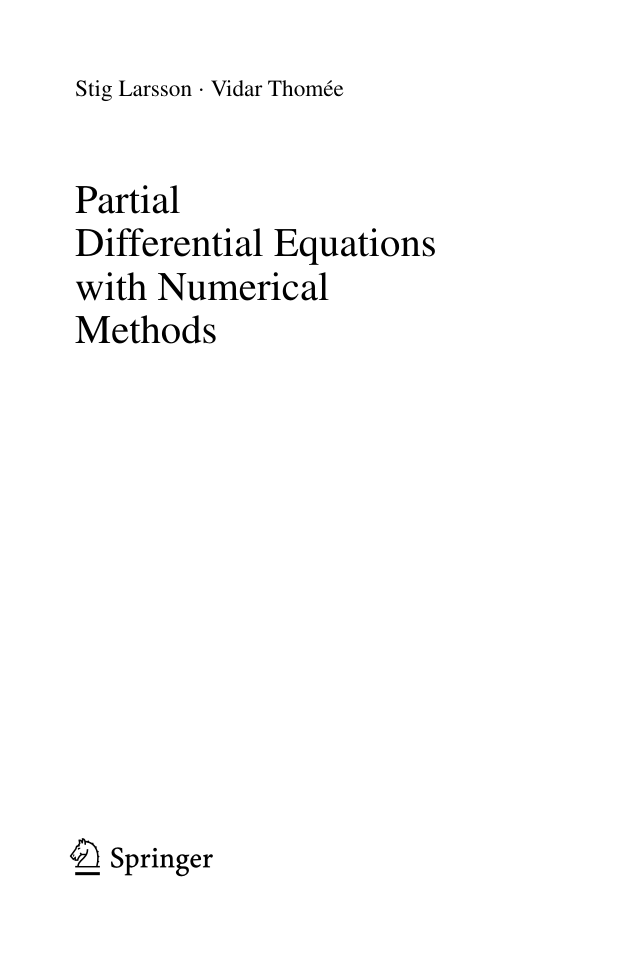
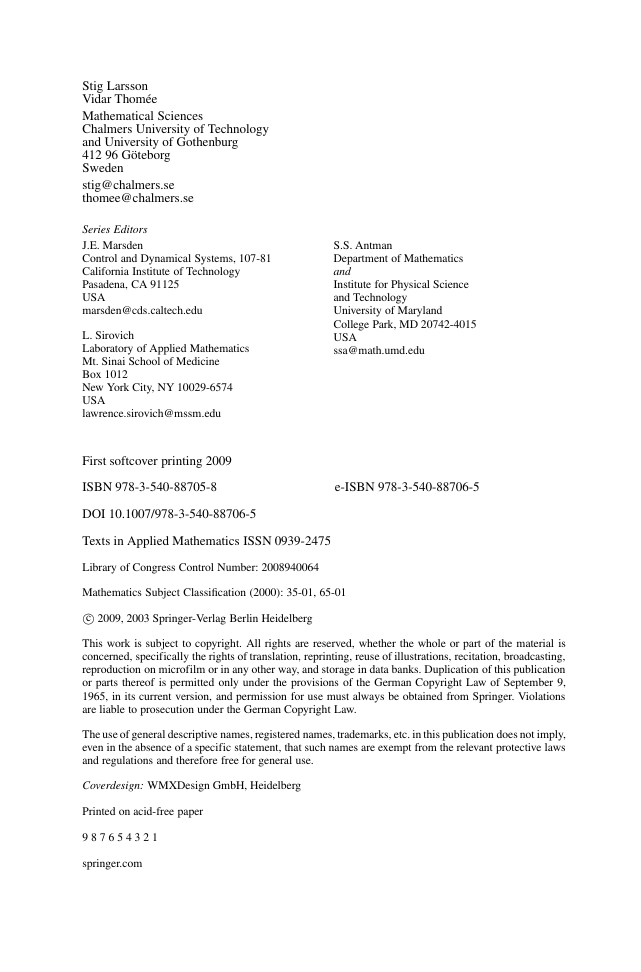


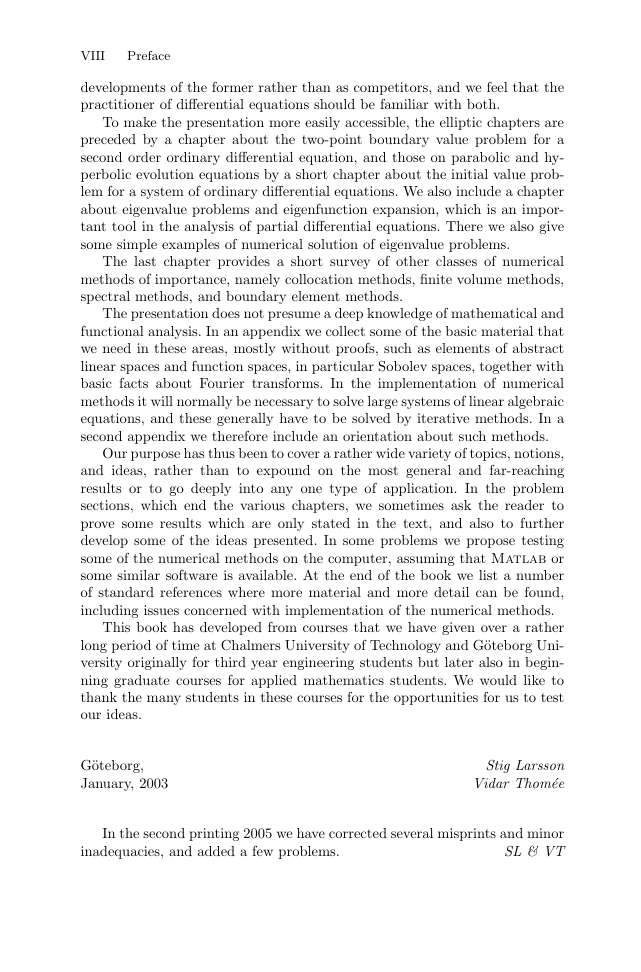
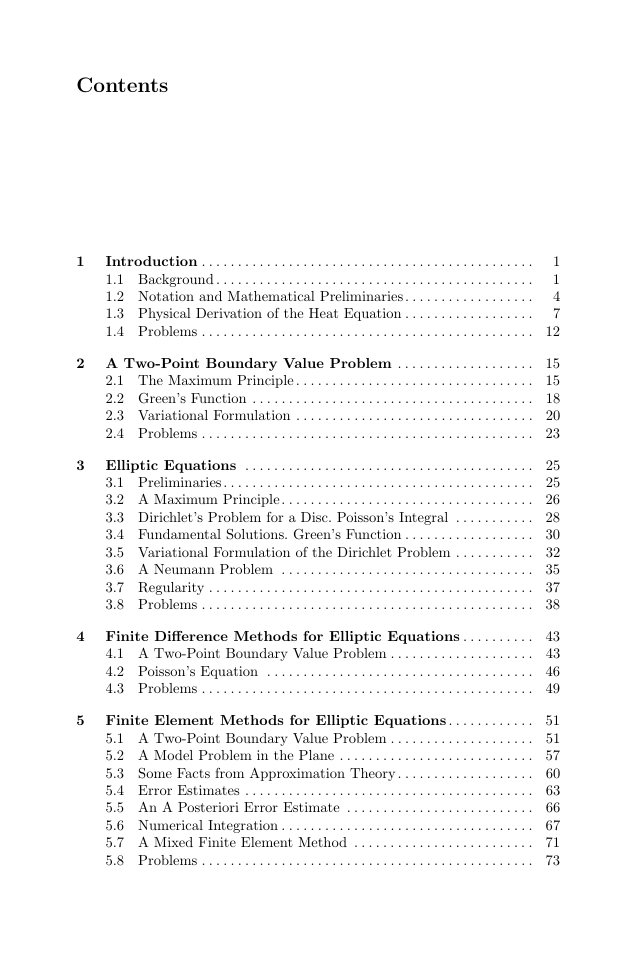








 2023年江西萍乡中考道德与法治真题及答案.doc
2023年江西萍乡中考道德与法治真题及答案.doc 2012年重庆南川中考生物真题及答案.doc
2012年重庆南川中考生物真题及答案.doc 2013年江西师范大学地理学综合及文艺理论基础考研真题.doc
2013年江西师范大学地理学综合及文艺理论基础考研真题.doc 2020年四川甘孜小升初语文真题及答案I卷.doc
2020年四川甘孜小升初语文真题及答案I卷.doc 2020年注册岩土工程师专业基础考试真题及答案.doc
2020年注册岩土工程师专业基础考试真题及答案.doc 2023-2024学年福建省厦门市九年级上学期数学月考试题及答案.doc
2023-2024学年福建省厦门市九年级上学期数学月考试题及答案.doc 2021-2022学年辽宁省沈阳市大东区九年级上学期语文期末试题及答案.doc
2021-2022学年辽宁省沈阳市大东区九年级上学期语文期末试题及答案.doc 2022-2023学年北京东城区初三第一学期物理期末试卷及答案.doc
2022-2023学年北京东城区初三第一学期物理期末试卷及答案.doc 2018上半年江西教师资格初中地理学科知识与教学能力真题及答案.doc
2018上半年江西教师资格初中地理学科知识与教学能力真题及答案.doc 2012年河北国家公务员申论考试真题及答案-省级.doc
2012年河北国家公务员申论考试真题及答案-省级.doc 2020-2021学年江苏省扬州市江都区邵樊片九年级上学期数学第一次质量检测试题及答案.doc
2020-2021学年江苏省扬州市江都区邵樊片九年级上学期数学第一次质量检测试题及答案.doc 2022下半年黑龙江教师资格证中学综合素质真题及答案.doc
2022下半年黑龙江教师资格证中学综合素质真题及答案.doc